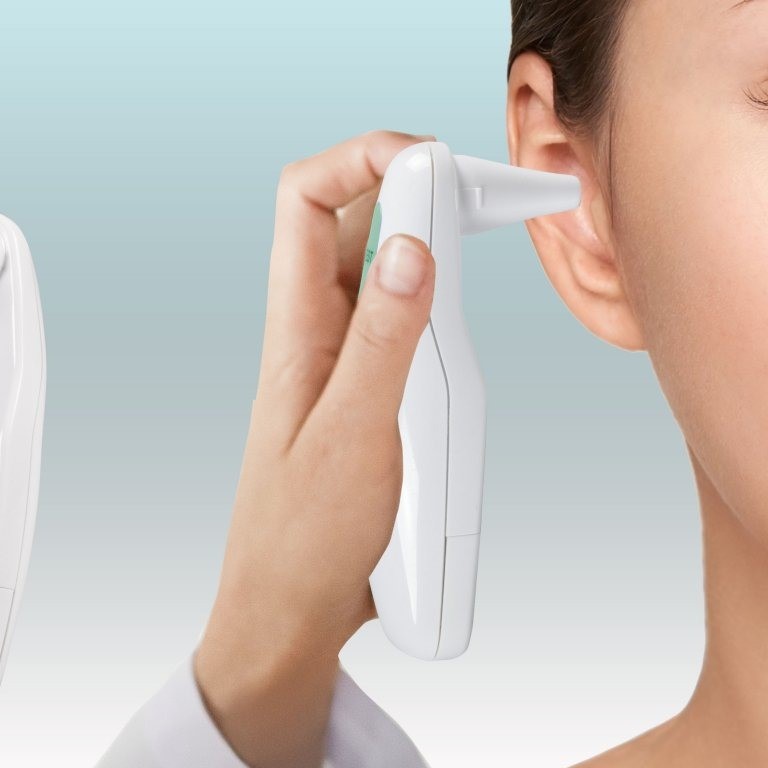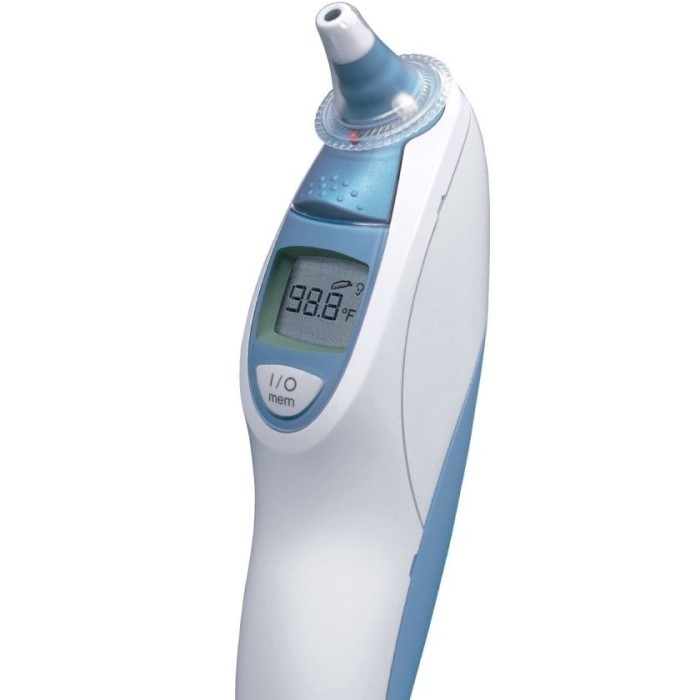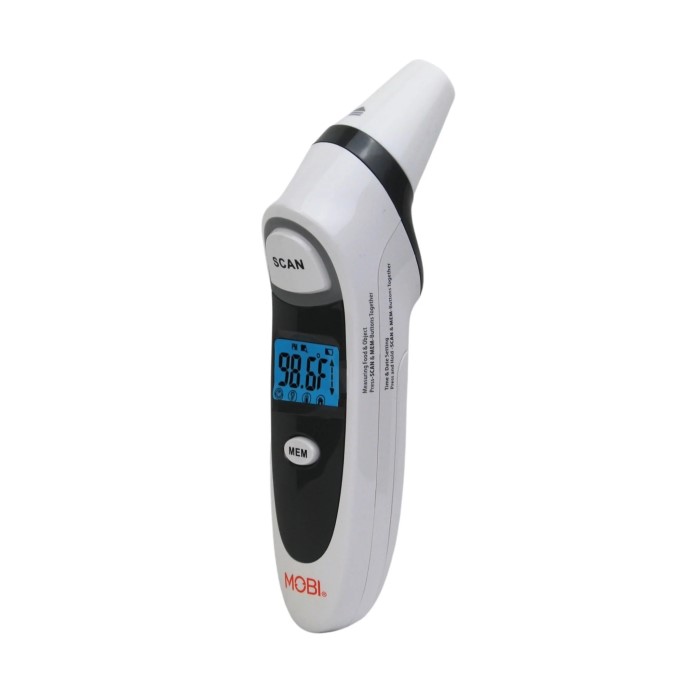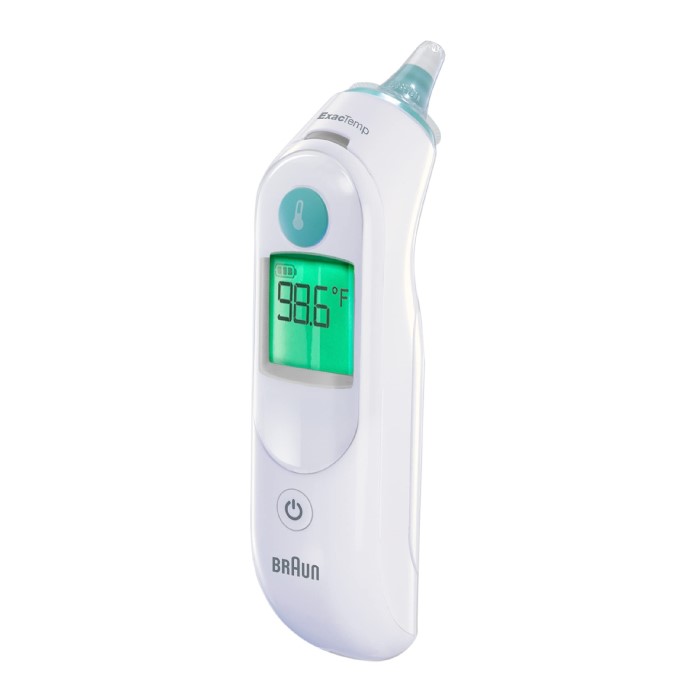What Is a Digital Ear Thermometer?
A digital ear thermometer is a device used to measure body temperature. It works by detecting heat from the eardrum and surrounding tissue. These thermometers are popular for their speed, accuracy, and ease of use. They are widely used for babies, children, and adults.
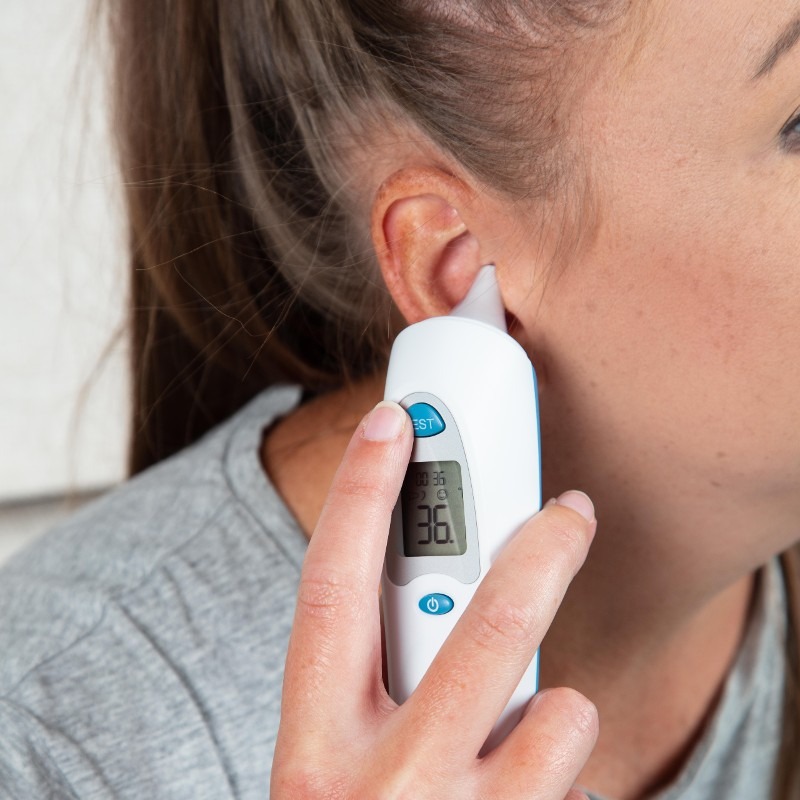
Explanation of Digital Ear Thermometer Features
Digital ear thermometers come with several features to enhance their functionality. Most models use infrared technology to read temperature without direct contact. They usually have easy-to-use buttons, allowing quick measurement. Features like a large digital display make readings simple to understand. Some models come with fever indicators or backlit screens for nighttime use. Advanced devices may store previous readings for easier tracking of health.
How It Measures Temperature Accurately
A digital ear thermometer uses the infrared heat emitted by the eardrum to measure temperature. The eardrum shares blood flow with the body’s temperature control center, making results precise. To ensure accurate readings, the probe of the thermometer must fit securely into the ear canal. Many thermometers alert users if the position is incorrect, improving accuracy further. These thermometers are preferred because they calculate temperatures quickly and reliably.
Benefits of Using
Speed and Convenience
Digital ear thermometers provide rapid and precise readings. They measure temperature within seconds, making them ideal for busy families or healthcare settings. This speed is especially useful for restless children who may struggle to sit still for long. Their convenient design ensures simple use, with intuitive buttons and features enhancing user experience. Many models also offer positioning feedback, ensuring accurate and effortless operation. Overall, their quick results save time while maintaining reliability.
Hygienic and Safe Temperature Measurement
Digital ear thermometers are designed to minimize the risk of spreading germs. They often include disposable probe covers, ensuring hygienic use for multiple users. The non-invasive infrared technology reduces discomfort, particularly helpful for infants and young children. These devices eliminate the need to share oral thermometers, providing a safer option for families and caregivers. Their safety and cleanliness make them a trusted choice for measuring body temperature effectively without compromising health.
Key Features
When selecting a digital ear thermometer, certain features are essential for optimal functionality. These features ensure accurate readings, ease of use, and long-term reliability. Here are the key attributes to consider when choosing a thermometer.
Accuracy and Reliability
Accuracy is crucial for monitoring body temperature effectively. Digital ear thermometers rely on infrared sensors for precise measurements. The ability to detect even slight temperature variations is vital, especially for infants and the elderly. Look for models with clear indicators for probe placement to ensure correct positioning in the ear canal. Reliable devices consistently deliver accurate readings, allowing users to trust the results and respond appropriately to health concerns.
Easy-to-Read Display
An easy-to-read display simplifies the process of checking temperature results. Large digital screens make readings visible, even in low lighting conditions. Backlit displays are particularly helpful for nighttime use. Thermometers with color-coded fever indicators can provide quick insights into the measurement range. Simple displays help avoid confusion and allow users to focus on managing health more effectively.
Memory Storage for Previous Readings
Digital ear thermometers with memory storage enhance convenience. They record past measurements, letting users track temperature trends over time. This feature is valuable for monitoring ongoing illnesses or assessing recovery progress. Choose models with sufficient storage capacity for multiple readings, especially in households or healthcare settings. Devices with memory functions reduce the need for manual record-keeping, making health tracking easier and more efficient.
Comparing Digital Ear Thermometers to Other Types of Thermometers
When selecting a thermometer, understanding the differences between types is essential. Digital ear thermometers are often compared with other common options like forehead and oral thermometers. Each type has distinct advantages and is suited to specific situations.
Ear Thermometers vs Forehead Thermometers
Digital ear thermometers and forehead thermometers both use infrared technology for readings. However, there are key differences:
Speed and Accuracy
- Faster Readings: Ear thermometers are known for their speed. They can provide readings in just a few seconds, making them an efficient choice for quick assessments. This is particularly useful when you need to monitor a child’s temperature urgently.
- Precise Measurements: One of the key advantages of ear thermometers is their accuracy. They measure the infrared heat emitted from the eardrum, which closely reflects the body’s core temperature. This leads to more reliable results compared to other methods.
- Comparison with Forehead Thermometers: On the other hand, forehead thermometers provide less accurate readings. They measure heat from the surface of the skin, which can be influenced by various external factors, such as ambient temperature. As a result, they may not be as reliable for detecting fever.
Ease of Use
- Non-invasive Nature of Forehead Thermometers: Forehead thermometers are especially user-friendly for infants and sleeping children. Their non-invasive design allows for easy and gentle temperature checks without disturbing the child. This feature makes forehead thermometers popular among parents for measuring young children’s temperatures during sleep or rest.
- Challenges with Ear Thermometers: In contrast, ear thermometers require proper positioning to ensure accurate readings. The probe must be correctly placed in the ear canal, which can be challenging with restless or squirmy kids. Maintaining the right angle and depth during measurement is crucial, which might require additional efforts from the caregiver.
Hygiene
- Disposable Probe Covers: Ear thermometers often come with disposable probe covers, which serve to enhance hygiene during usage. Using a fresh cover for each measurement helps prevent cross-contamination between users, minimizing the risk of spreading germs, especially in a household with multiple family members.
- Cleaning Forehead Thermometers: Forehead thermometers, while easy to use, may require cleaning after each use. To maintain safety and hygiene, it’s important to wipe down the device with disinfectant or follow the manufacturer’s cleaning instructions. This additional step can be somewhat inconvenient compared to the disposable approach of ear thermometers.
Environmental Factors
- Influence of External Conditions on Forehead Thermometers: The accuracy of forehead thermometer readings can be significantly affected by environmental conditions. For example, sweat on the forehead or exposure to cold air can alter the surface temperature, leading to inaccurate readings. Therefore, it’s important to consider these factors when measuring temperature with a forehead thermometer.
- Stability of Ear Thermometer Readings: Ear thermometers, in contrast, are less vulnerable to environmental influences. Since they measure the temperature directly from the eardrum, external factors like sweat or temperature changes in the air have minimal impact on the results. This makes ear thermometers a more stable option for consistent and reliable readings across various conditions.
Both options are popular, but ear thermometers are preferred for higher accuracy.
Ear Thermometers vs Oral Thermometers
Oral thermometers have long been a household staple, but ear thermometers offer notable benefits:
- Comfort and Safety: Ear thermometers are non-invasive and comfortable for kids, adults, and the elderly. Oral thermometers may cause discomfort and are unsuitable for individuals who cannot keep them in place.
- Speed: Digital ear thermometers deliver readings in seconds, while oral thermometers take much longer.
- Hygiene: Sharing oral thermometers requires meticulous cleaning to prevent germ spread. Ear thermometers with probe covers offer a cleaner alternative.
- Suitability: Babies and younger children may struggle with oral thermometers. Ear thermometers are much easier to use for this age group.
These comparisons highlight the practicality of digital ear thermometers. They are precise, hygienic, and suitable for all age groups, making them an excellent choice for families and healthcare settings.
How to Use a Digital Ear Thermometer Properly
Using a digital ear thermometer correctly ensures accurate and reliable temperature readings. Following proper steps and techniques minimizes errors and enhances the device’s efficiency. Here’s how you can use it effectively.
Step-by-Step Guide to Using the Device
- Prepare the Thermometer: Turn on the thermometer. Attach a clean, disposable probe cover.
- Position the Patient: Ensure the person is sitting or lying comfortably. For children, hold their head gently.
- Insert the Probe: Pull the ear gently back to straighten the ear canal. Insert the probe snugly.
- Take the Temperature: Press the measurement button and wait for the beep, indicating the reading is complete.
- Remove and Read: Remove the thermometer. Check the temperature on the digital display.
- Dispose of the Cover: Discard the used probe cover to maintain hygiene. Return the thermometer to storage.
Tips for Ensuring Accurate Results
- Check Positioning: Improper probe placement can affect reading accuracy.
- Use in the Correct Ear: Always use the same ear for consistent temperature tracking.
- Avoid Blockages: Ensure the ear is free of wax or other obstructions before measurement.
- Follow Timing: Wait a few minutes after ear exposure to cold or heat before taking a reading.
- Keep Still: Ensure the person remains still during measurement to avoid incorrect data.
- Calibrate Regularly: Follow the manufacturer’s recommendations to keep the device accurate.
Using a digital ear thermometer properly provides fast, precise, and hassle-free results. Maintaining correct practices ensures consistent readings and better health monitoring.
Maintenance and Care
Maintaining your digital ear thermometer ensures accurate readings and extends its lifespan. Proper care helps avoid hygiene issues and mechanical malfunctions. Follow these tips for cleaning, storing, and maintaining your device.
Cleaning and Storage Instructions
- Clean the Probe After Every Use: Wipe the probe with a soft, damp cloth or alcohol-based solution. Avoid submerging the thermometer in water. Use disposable probe covers to reduce contamination.
- Follow Manufacturer’s Guidelines: Read the user manual for recommended cleaning methods.
- Store Properly: Keep the thermometer in its protective case to avoid dust and damage. Avoid extreme heat or moisture, as these can affect its performance.
- Keep It Away from Children: Store in a safe place to prevent accidental damage or misuse.
Regular cleaning and proper storage ensure the device remains safe and functional for long-term use.
Battery Replacement and Longevity Tips
- Monitor Battery Levels: Check the display for any low-battery indicators. Replace batteries promptly for uninterrupted use.
- Use the Correct Battery Type: Only use batteries recommended in the user manual.
- Remove Batteries if Not in Use: If stored for an extended period, remove batteries to prevent leaks.
- Invest in Quality Batteries: High-quality batteries last longer and reduce the chance of unexpected failure.
- Turn Off After Use: Save battery life by switching off the device immediately after use if it doesn’t shut off automatically.
Proper battery care avoids interruptions and ensures reliable performance when you need the thermometer.
By cleaning, storing, and maintaining your digital ear thermometer carefully, you can maximize its lifespan and efficiency. Regular upkeep also ensures accurate and hygienic usage.
Popular Brands and Models
Overview of Leading Brands
When considering a digital ear thermometer, several brands stand out for their reliability and innovation. Renowned names like Braun, Vicks, and iProven are popular for producing durable and accurate thermometers. Braun offers a wide range of models known for precision and user-friendly designs. Vicks is favored for its affordability and simple functionality, perfect for home use. iProven combines advanced technology with practical features, ensuring comfort and ease for all users. Brands like ThermoScan are preferred by healthcare professionals due to their clinical-grade accuracy.
Features of Highly Rated Models
Highly rated digital ear thermometers combine accuracy, convenience, and advanced features. Many top models use infrared sensors for fast, precise measurements. Devices like Braun ThermoScan include pre-warmed tips for increased accuracy. Easy-to-read displays are a key feature, with backlit screens for nighttime readings. Memory storage functions allow users to track previous measurements effortlessly. Some models offer fever alarms with color-coded indicators for quick assessment. Thermometers with disposable probe covers enhance hygiene and simplify maintenance. High-quality devices focus on intuitive design, ensuring usability for both adults and children.
Choosing a trusted brand and model ensures reliable performance and long-term satisfaction with your thermometer.
Buying Guide
Considerations Based on Age Group
Choosing the right digital ear thermometer depends on the age of the user. For infants and young children, prioritize thermometers with non-invasive features and small tips. Devices with positioning aids can ensure accurate readings for restless toddlers. For adults, focus on thermometers with advanced features like memory storage and fever indicators. Elderly users benefit from models with larger, easy-to-read displays for better usability. Select a thermometer suitable for all age groups if used across the family.
Budget and Price Range Factors
Budget is a key factor when selecting a thermometer. Lower-priced models provide basic features like fast and accurate readings. Mid-range devices often include enhancements like memory storage and fever alerts. High-end options offer advanced features like pre-warmed tips and backlit displays. Consider long-term value by choosing a durable thermometer with replaceable parts. Look for models with warranties to ensure lasting reliability. Balance cost with features to pick the best device for your needs.
Conclusion
In conclusion, choosing the right digital ear thermometer is essential for maintaining your family’s health. With their quick response times, accuracy, and ease of use, these devices are invaluable, especially for parents monitoring their children’s health.
By understanding which features to prioritize and how to use your digital ear thermometer effectively, you can ensure reliable temperature readings. Remember, making informed decisions about health tools leads to better care and peace of mind.
Investing in a high-quality digital ear thermometer not only benefits immediate health needs but also prepares you for future health assessments, ensuring your family remains safe and healthy.
